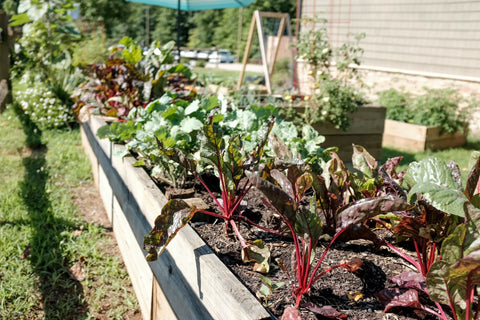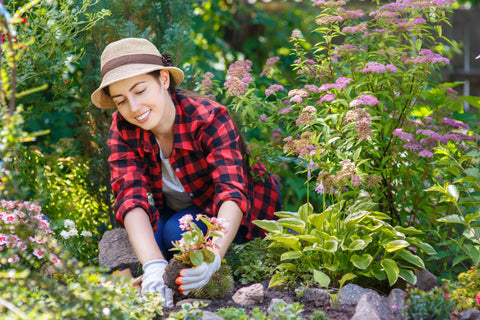In the realm of modern gardening, the concept of organic greenhouse gardening has gained significant traction, offering a harmonious approach to cultivating plants in a controlled environment. This method not only provides a sanctuary for plants but also promotes sustainability by embracing a chemical-free philosophy. In this blog, we'll delve into the world of "Organic Greenhouse Gardening," exploring tips and techniques to foster a thriving, chemical-free oasis that not only yields healthy produce but also contributes to a greener, more sustainable future.

The Greenhouse Advantage: A Haven for Organic Growth
Controlled Environment:
Greenhouses provide a controlled environment where temperature, humidity, and light can be optimized for plant growth. This controlled setting becomes the canvas for organic gardening, allowing for a more mindful and sustainable approach.
Year-Round Cultivation:
The greenhouse extends the growing season, enabling year-round cultivation. This continuous production eliminates the need for off-season chemical interventions, fostering a more natural and balanced ecosystem within the structure.
Choosing Organic Seeds and Seedlings: The Foundation of Sustainability
Certified Organic Seeds:
The journey to a chemical-free greenhouse garden begins with the selection of organic seeds. Certified organic seeds ensure that your plants start their life cycle without exposure to synthetic pesticides or genetically modified organisms (GMOs).
Healthy Seedlings:
Opt for strong and healthy seedlings from reputable sources. Vigorous seedlings are more resilient to pests and diseases, reducing the need for chemical interventions later in the growth cycle.
Soil Health: The Root of Organic Success
Compost Enrichment:
Building healthy soil is crucial for organic greenhouse gardening. Enrich the soil with compost, a nutrient-rich organic matter that enhances soil structure, fertility, and water retention. Compost also promotes beneficial microbial activity, contributing to a thriving ecosystem.
Natural Amendments:
Utilize natural soil amendments such as well-rotted manure, bone meal, and organic matter to fortify the soil with essential nutrients. These amendments improve soil texture and provide a balanced nutrient profile for plants.

Companion Planting: Nature's Pest Control
Strategic Plant Pairing:
Embrace the concept of companion planting to naturally deter pests. Certain plants have inherent properties that repel pests or attract beneficial insects. For example, planting marigolds alongside tomatoes can discourage nematodes, promoting a healthier, chemical-free environment.
Diversity for Resilience:
Cultivate a diverse range of plants in your greenhouse. Biodiversity not only enhances the visual appeal but also contributes to a more resilient ecosystem. Different plant species can provide natural support and protection to one another.
Beneficial Insects: Nature's Pest Management Crew
Ladybugs for Aphid Control:
Introduce beneficial insects like ladybugs to combat common pests such as aphids. Ladybugs are voracious predators that feast on aphids, maintaining a natural balance without the need for chemical pesticides.
Predatory Mites:
Deploy predatory mites to control spider mite infestations. These tiny arachnids are natural predators and help keep harmful mite populations in check, preventing the need for chemical interventions.
Organic Pest Control: Homemade Remedies
Neem Oil Spray:
Neem oil, derived from the neem tree, is a natural pesticide with insecticidal and fungicidal properties. A neem oil spray can effectively control pests while being gentle on beneficial insects and the overall greenhouse environment.
Garlic and Pepper Spray:
Create a homemade spray using garlic and pepper to deter pests. This concoction is a natural and safe alternative to chemical pesticides, providing a barrier against unwanted visitors.

Watering Wisely: Conservation and Prevention
Drip Irrigation:
Implement drip irrigation systems to provide consistent and targeted watering. Drip systems minimize water waste and reduce the likelihood of fungal diseases, ensuring a healthier greenhouse ecosystem.
Morning Watering:
Water plants in the morning to allow sufficient time for foliage to dry before the cooler evening temperatures. This practice helps prevent the development of fungal issues, reducing the reliance on chemical fungicides.
Crop Rotation: Preventing Disease Naturally
Breaking Disease Cycles:
Practice crop rotation to disrupt the cycles of soil-borne diseases. Moving crops to different locations within the greenhouse helps prevent the buildup of pathogens, minimizing the need for chemical treatments.
Strategic Planning:
Plan your greenhouse layout with crop rotation in mind. Consider the specific needs and vulnerabilities of each plant species, strategically rotating them to optimize soil health and minimize disease risks.
Conclusion: Nurturing a Chemical-Free Oasis
As we embark on the journey of organic greenhouse gardening, it becomes clear that the path to sustainability is intertwined with a commitment to chemical-free practices. From choosing organic seeds to fostering a diverse and resilient ecosystem, every step contributes to the creation of a nurturing oasis within the greenhouse. By embracing nature's principles, utilizing beneficial insects, and minimizing the reliance on chemical interventions, we not only cultivate thriving plants but also foster a greener and more sustainable future. Let your greenhouse become a sanctuary of organic growth—a testament to the beauty of nature, nurtured with care and dedication.









